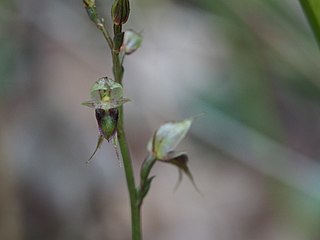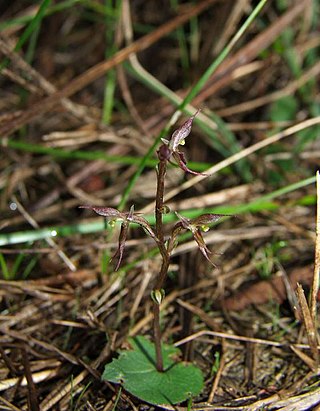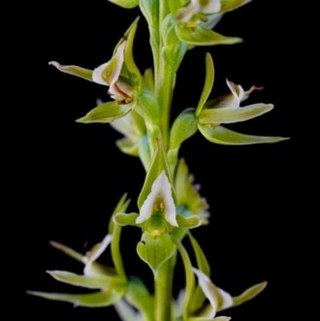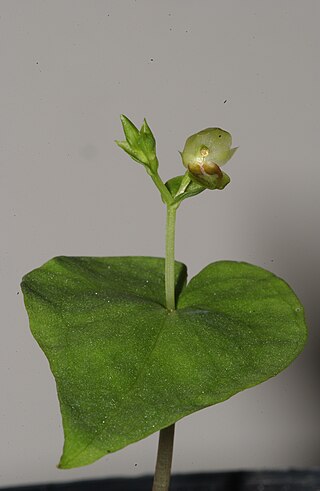
Acianthus, commonly known as mosquito orchids, is a genus of about twelve species of plants in the orchid family, Orchidaceae. Mosquito orchids are terrestrial herbs with a single, heart-shaped, usually ground-hugging leaf and one to many small, green, pinkish or purplish flowers on a fleshy stalk. They are found in New Caledonia, Australia and New Zealand.

Acianthus fornicatus, commonly known as bristly mosquito orchid or pixie caps, is a species of flowering plant in the orchid family Orchidaceae and is endemic to eastern Australia. It is a terrestrial herb with a single, heart-shaped leaf and up to ten translucent pinkish-red flowers, and is widespread and common in coastal and near-coastal areas.
Acianthus borealis, commonly known as northern mosquito orchid, is a species of flowering plant in the orchid family Orchidaceae and is endemic to Queensland in Australia. It is a glabrous, terrestrial herb with a single, heart-shaped leaf and between two and twenty transparent pinkish flowers with reddish markings and is widely distributed on the eastern tablelands.

Acianthus collinus, commonly known as hooded mosquito orchid or inland mosquito orchid, is a species of flowering plant in the orchid family Orchidaceae and is endemic to south-eastern continental Australia. It is a terrestrial herb with a single, heart-shaped leaf and between two and nine translucent pinkish flowers with reddish markings and is found growing in colonies on sheltered slopes in open forest in on the western slopes of the Great Dividing Range.

Acianthus exiguus, commonly known as tiny mosquito orchid, is a flowering plant in the orchid family Orchidaceae and is endemic to New South Wales in Australia. It is a terrestrial herb with a single, heart-shaped leaf and up to five translucent greenish-white flowers with pinkish markings and is found growing in forests on the north coast of the state.

Acianthus exsertus, commonly known as gnat orchid or large mosquito orchid, is a species of flowering plant in the orchid family Orchidaceae and is endemic to eastern Australia. It is a terrestrial herb with a single, heart-shaped leaf and up to 25 small, fine, dark brown flowers with pinkish and purplish markings and is found growing in sheltered places in forests in Queensland, New South Wales the ACT and Victoria.

Acianthus pusillus, commonly known as small mosquito orchid, is a species of flowering plant in the orchid family Orchidaceae and is endemic to eastern Australia. It is a terrestrial herb with a single, heart-shaped leaf and up to 18 small, translucent green or pinkish flowers with reddish marking and a green to reddish-purple labellum. It is widely distributed, growing in moist places from central-eastern Queensland, south through New South Wales and Victoria to South Australia and Tasmania.

Prasophyllum petilum, commonly known as the Tarengo leek orchid, is a species of orchid endemic to eastern Australia. It has a single tubular, green leaf and up to eighteen pinkish mauve to greenish flowers, well-spaced along a slender flowering stem. It is a small orchid, difficult to locate, generally growing in taller grasses.

Prasophyllum montanum, commonly known as the mountain leek orchid, is a species of orchid endemic to eastern Australia. It has a single tubular, green leaf and up to fifty scented, greenish to pinkish flowers. It grows in montane ecosystems at altitudes above 1,500 m (5,000 ft).

Prasophyllum caudiculum, commonly known as the Guyra leek orchid, is a species of orchid endemic to a small area of northern New South Wales. It has a single tubular, bright green leaf and up to thirty five greenish to reddish-brown flowers crowded along an erect flowering stem. It grows in grassy places near Guyra.

Prasophyllum dossenum is a species of orchid endemic to a small area of northern New South Wales. It has a single tubular, dark green leaf and up to thirty scented pinkish-white and greenish-brown flowers crowded along an erect flowering stem. It is a rare orchid which grows in grassy places on the Northern Tablelands of New South Wales.
Prasophyllum readii, commonly known as the Streathem leek orchid, is a species of orchid endemic to Victoria. It has a single, tubular leaf and up to twenty five scented, greenish-brown to reddish-brown flowers with a white or pinkish labellum and is only known from a swamp in the south-west of the state.
Genoplesium confertum, commonly known as the crowded midge orchid, is a small terrestrial orchid endemic to the south-east of Queensland. It has a single thin leaf fused to the flowering stem and up to sixty small, densely crowded, reddish and green flowers and grows in coastal heath.
Genoplesium morinum, commonly known as the mulberry midge orchid, is a species of small terrestrial orchid that is endemic to New South Wales. It has a single thin leaf fused to the flowering stem and up to twenty crowded, dark reddish purple flowers. It has been known as "mulberries on sticks".
Genoplesium pedersonii, commonly known as Pederson's midge orchid, is a species of small terrestrial orchid endemic to the Blackdown Tableland in Queensland. It has a single thin leaf fused to the flowering stem and up to thirty small, greenish red to reddish, self-pollinating flowers with a dark purplish red labellum. The species is treated as Corunastylis pedersonii in Queensland.
Genoplesium turfosum, commonly known as the alpine midge orchid, is a small terrestrial orchid endemic to a small area in the higher parts of New South Wales. It has a single thin leaf fused to the flowering stem and up to twenty five dark purplish-red, crowded flowers with a sparsely hairy labellum.
Pterostylis atrosanguinea, commonly known as the crowded banded greenhood, is a plant in the orchid family Orchidaceae and is endemic to the south-west of Western Australia. The plants either have a rosette of leaves in the years when not flowering or stem leaves on a flowering spike. When flowering, it has up to twenty flowers that are dark reddish to blackish brown with translucent white areas. The labellum is dark reddish black and covered with short, stiff hairs.
Chiloglottis trullata, commonly known as the triangular ant orchid, is a species of orchid endemic to Queensland, Australia. It has two dark green leaves and a single small, green or pinkish flower with a shiny, dark reddish black, insect-like callus surrounded by reddish club-shaped calli covering most of the upper surface of the labellum.
Arthrochilus sabulosus, commonly known as the spotted elbow orchid, is a flowering plant in the orchid family (Orchidaceae) and is endemic to Tropical North Queensland and Horn Island. It has a rosette of dull green leaves on side growth at its base and up to fifteen pale green, insect-like flowers with reddish to brownish glands on its labellum.

Acianthus saxatilis is a species of flowering plant in the orchid family Orchidaceae and is endemic to Queensland. It is a terrestrial herb with a single, relatively large, heart-shaped leaf and usually up to 5 translucent greenish-brown to greenish-yellow flowers.











